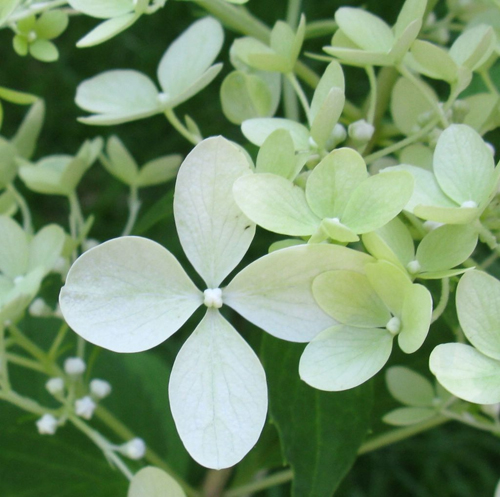Hydrangea paniculata Phantom
Panicle hydrangea is an oriental flower. From time immemorial, it was grown in Japan and China. Thanks to the science of breeding, many varieties with new qualities have been bred on the basis of this culture. Most of the features of her wild ancestor were absorbed by the beautiful Phantom - a plant that can decorate a backyard in natural areas with unfavorable climatic conditions.

Description of appearance
The Phantom variety is quite popular among flower growers. And there is something to love him for. This is easy to understand if you imagine a sprawling bush of impressive size (2.5 meters in height and up to 2 meters in width), formed by strong red-brown stems, on which dense large flower brushes are formed up to 30, and sometimes up to 50 see Despite the severity of blossoming inflorescences, strong shoots of culture do not bend, but rush vertically upward. The dark green leaves of the plant have a pointed apex, an oblong shape and finely toothed edges. With the arrival of autumn, they change their color to yellow.
The inflorescences of the culture are broad-pyramidal and consist of large sterile flowers. In a fully blossoming inflorescence, the top is loose, while it itself is quite dense. Like many varieties of panicle hydrangea, the color of this species changes throughout the flowering period: from creamy white at the beginning of the phase to light cream and pale pink in the second half. Phantom inflorescences are not only incredibly beautiful, but also smell good. Their scent spreads throughout the garden, with sweet honey notes.

This variety of hydrangea is characterized by abundant flowering, lasting from July to October. It begins when the shrub reaches the age of 4 or 5 years. If you pay attention to timely pruning, you can achieve flowering plants throughout its life. And the Phantom can live on your site for up to 40 years with good care.
The variety is highly resistant to low temperatures, although it is advisable to cover young plants for the winter. However, even in case of freezing, Phantom's shoots are able to quickly recover. The plant is practically not exposed to root rot, and the risk of this disease remains low even in conditions of prolonged damp weather.
Features of agricultural technology
For normal growth and intensive development of the culture, it is necessary to provide a large amount of sunlight. However, it will be better if the plant is in partial shade in the afternoon. It is preferable to place shrubs near buildings or in the vicinity of other tall perennials. This is to protect the Phantom from drafts.

Water the hydrangea once every 10 days as the top layer of the soil dries up. Under one adult plant, 2 buckets of not cold, settled water are poured at a time; for young specimens, this volume is halved. Feed the flower twice a month with liquid organic fertilizers: for example, stale mullein, or green fertilizer from dry grass. It is simply added to the water for irrigation. At the budding stage, the variety needs fertilizers containing phosphorus and potassium. They are scattered around the flower bush at some distance.
The luxurious beauty Phantom is planted in a half-meter planting pit filled with a mixture of fertile soil and peat. It is desirable that the soil has a slightly acidic or neutral pH. Alum is used to acidify the soil under the flower. It should be noted that all preparatory work is carried out a month before the landing itself. After a few weeks, green leaves appear on the established seedling.
Hydrangeas require annual pruning. The best time for it is late autumn. Pruning is necessary for the healing of the shrub, therefore, during this procedure, frozen, weak shoots and faded inflorescences should be removed. If your pet is already many years old, cut it for rejuvenation so that a stump remains. For shelter for the winter, use a mixture of soil and humus or peat.
It should be noted that the Phantom is prone to chlorosis. To eliminate this disease, you should use the drugs Antichlorosis or Ferovit.
Use cases
An ornamental plant can become a vibrant, if not the centerpiece of your flower garden. The variety stands out for the tenderness of flowers in group plantings, attracts attention, being a lonely shrub. Landscaping professionals use this crop for hedges and front gardens. The phantom is included in solitary plantings, in belt plantations on the sides of garden paths. Panicle hydrangea looks beautiful in combination with evergreens.








